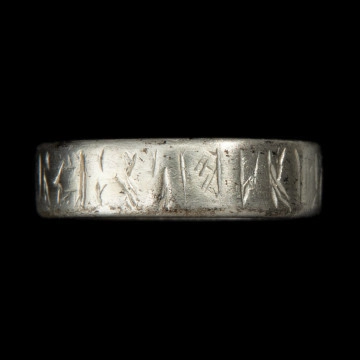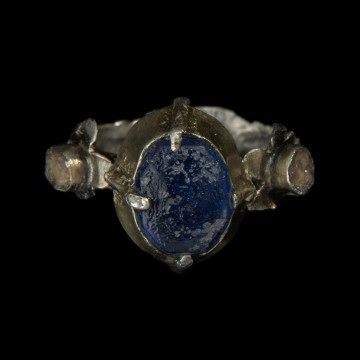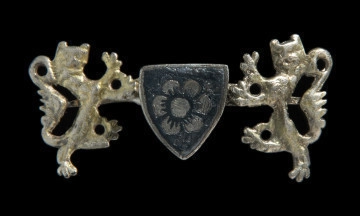
Wedding ring
przełom XIV i XV wieku
National Museum in Szczecin
Part of the collection: Szczecin treasure from Podzamcze
A signet, a kind of decorative ring, was intended only for men; originally, it was used as a seal. On its surface, it was usually engraved with an image of a coat of arms or a monogram as the owner's distinctive sign. Rings fulfilling the function of a seal were already known in ancient Rome, where they were used as a personal signet ring used to authenticate letters. They were used throughout the Middle Ages, serving to legalise and protect documents against unauthorised persons. They were used by people holding important offices or positions. Bourgeois, representatives of the lower classes, used seals in the shape of polygons. Signet rings were often made of precious stones, which were set in gold or silver. They were worked in the intaglio technique, i.e. in-depth printing. Signet rings made entirely of precious metals were also popular, such as the example discovered in 1999 at Szczecin Podzamcze. Together with other jewellery items, costume ornaments and coins, it was found in a metal vessel hidden under the floor of one of the houses at Targ Rybny (the Fish Market). The valuables probably belonged to a local patrician. The ring is made of gilded silver and has a hexagonal mesh with an image of a hedgehog, which could have been an element of the Szczecin patrician's coat of arms. In the Middle Ages, a hedgehog was a symbol of the devil, greed, and, due to its sharp spikes, a symbol of anger.
Małgorzata Peszko
Author / creator
Dimensions
cały obiekt: diameter: 2,35 cm
Object type
body adornment, adornment
Creation time / dating
Creation / finding place
Identification number
Location / status

unknown
przełom XIV i XV wieku
National Museum in Szczecin

unknown
National Museum in Szczecin

unknown
przełom XIV i XV wieku
National Museum in Szczecin
DISCOVER this TOPIC
Museum of King Jan III's Palace at Wilanów
DISCOVER this PATH
Educational path
0/500

We use cookies to make it easier for you to use our website and for statistical purposes. You can manage cookies by changing the settings of your web browser. More information in the Privacy Policy.
We use cookies to make it easier for you to use our website and for statistical purposes. You can manage cookies by changing the settings of your web browser. More information in the Privacy Policy.
Manage cookies:
This type of cookies is necessary for the website to function. You can change your browser settings to block them, but then the website will not work properly.
WYMAGANE
They are used to measure user engagement and generate statistics about the website to better understand how it is used. If you block this type of cookies, we will not be able to collect information about the use of the website and we will not be able to monitor its performance.